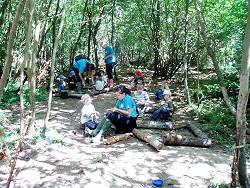Summary
 The Forest Education Initiative (FEI) was created in 1992. The FEI is a partnership of a broad range of bodies including civil society organisations, government organisations and the forestry and education sectors. A review of FEI was undertaken in 2009-2010 to explore its history and development and identify strengths and weaknesses and opportunities for the future. The aims of FEI are to:
The Forest Education Initiative (FEI) was created in 1992. The FEI is a partnership of a broad range of bodies including civil society organisations, government organisations and the forestry and education sectors. A review of FEI was undertaken in 2009-2010 to explore its history and development and identify strengths and weaknesses and opportunities for the future. The aims of FEI are to:
Increase the understanding and appreciation, particularly among young people of the environmental, social and economic potential of trees, woodlands and forests and of the link between the tree and everyday wood products.
Research Objectives
- Document the history, processes and activities of FEI and how it has developed.
- Focus on the activities/aims of FEI: what activities are taking place, are the aims seen as appropriate and relevant to those involved.
- Explore the relationships between the various organisations and individuals involved.
- Better understand the activities of the cluster groups.
- Investigate the governance and funding processes of the FEI network and projects.
- Look to the future: what are the current strengths and weaknesses of FEI and what opportunities are there for the future of the network
Findings and Recommendations
The work was undertaken through an analysis of documents, a range of interviews and a survey of cluster groups across Britain. Forty four of the seventy three cluster groups in early 2010 responded to the survey. Key findings include the following:
Governance
- The Forestry Commission (FC) in England, Scotland and Wales is the main driver and partner of FEI.
- At least 245 partners have been involved in FEI Partnership funded activities from 2003-2009. Approximately 182 of these were individual organisations; this figure includes about 24 different local authorities.
- FEI reaches schools, communities and teachers through its partnership network.
Funding
- FEI awarded funds of approximately £442,806 between 2003 and 2009. Every £1 awarded by FEI is at least match funded and is sometimes exceeded by funds and resources from other sources.
- Many funding bids for forest education activity require a local network, partners and a system for working with schools and communities. This is primarily the purpose and role of FEI.
Cluster groups
- The total number of participants involved in FEI activities across GB in 2009 was estimated to be 14,776.
- An estimated 1,405 people were cluster group members in March 2010.
- The key types of activities being undertaken by cluster groups included:
- Networking and support
- Forest School – delivery, training and networking
- FEI funded projects
- The top three motivations for membership of FEI are:
- Opportunities to network regionally
- Opportunities to access funding
- Support for Forest School delivery.
- The key value of FEI as identified by members is:
- Support from other members of cluster groups
- Opportunities to apply for funding
- Opportunity to attend the national networking day
- Support and expertise from the FEI coordinators.
Strengths
- A key value of FEI is the flexibility of its governance structure with coordinators and steering groups acting as an umbrella of support for cluster groups that can develop and fade depending on local need and enthusiasm.
- FEI is a wide ranging and effective network that supports a broad variety of people and groups (teachers, rangers, education providers, private forestry) to work with a diverse range of people in local schools and communities.
- The range, diversity and size of cluster groups across GB reflect local needs and interests.
Weaknesses
- There appears to be a lack of knowledge and understanding of what FEI is both internally within the cluster groups and amongst partner organisations and externally with other organisations and the wider public.
- Lack of well designed monitoring and evaluation means that key activities and achievements of FEI are not fully captured.
Opportunities
- Publicise the activities and benefits of FEI to the forestry sector with a focus on encouraging organisations to develop their corporate social responsibility by getting involved.
- Develop an appropriate monitoring and evaluation system that captures the relevant activity that FEI facilitates. Identify the key data needed to publicise and outline the benefits of FEI.
General Content
Funders and partners
![]()
![]()
![]()
The Forestry Commission in England, Scotland and Wales funded the research.
Forestry Commission policy
The Forestry Commission wishes to maximise the social benefits of woodlands. This requires an understanding of the ways in which contemporary society relates to and uses forests in both urban and rural areas through a range of activities such as education and learning.
Status
The project is now complete, and the report is available. Research summary including background, methods and findings (PDF-152K)

